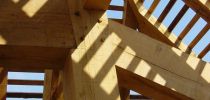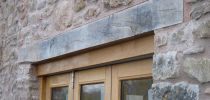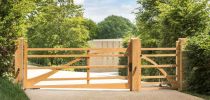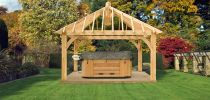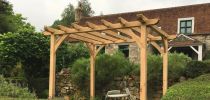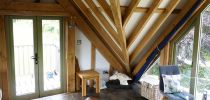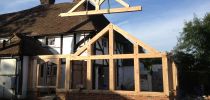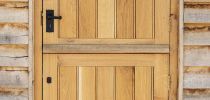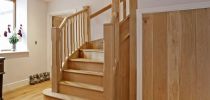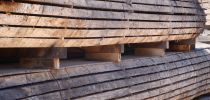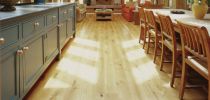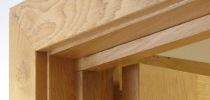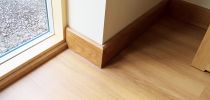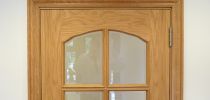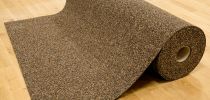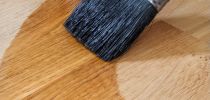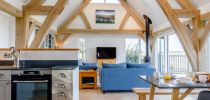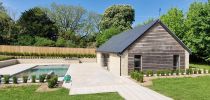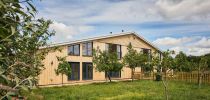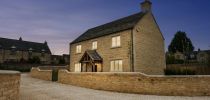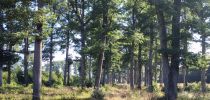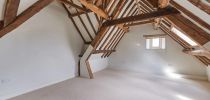

The Revival of Oak Framing
A Timeless Craft in Modern Construction
2nd April 2024
In an era dominated by steel and concrete structures, the art of oak framing is experiencing a remarkable revival. Rooted in centuries of tradition, oak framing combines craftsmanship with durability, offering a sustainable and aesthetically pleasing alternative for modern construction projects. This article explores the resurgence of the oak framing trade, its diverse applications, the allure that draws people towards it, and the intricate techniques involved.
Once a staple in construction throughout history, oak frames have experienced a resurgence in recent years, driven by a growing appreciation for a traditional build technique, combined with sustainable construction practices and a desire for structures that stand the test of time. Architects, builders, and homeowners alike are rediscovering the inherent strength and beauty of oak, bringing this age-old craft back into the forefront of construction.

Photo: Black Pig Frame
The versatility of oak framing extends across a broad spectrum of structures, from residential homes to commercial buildings and even agricultural barns. The warm, rustic charm of oak creates a timeless aesthetic that complements both traditional and contemporary designs. Oak frames are employed in various architectural elements, including garages, porches, verandas, pergolas, orangeries and trusses and entire houses, as well as other decorative features, providing a durable and visually appealing alternative to conventional building materials.
So why choose an oak frame?
Durability and Longevity
Oak is renowned for its strength and durability, so much so, that structures built with oak frames often have a life expectancy measured in centuries rather than decades! This longevity not only reduces the need for frequent maintenance but also contributes to a much more sustainable approach, as the environmental impact of constant renovations is minimised.

Photo: Carpenters Oak, also header image.
A great example of the longevity of Oak is the Palace of Westminster, the oldest building in the parliamentary estate. It boasts the most impressive use of hammerbeam trusses in British architecture, commissioned by Richard the second in 1393. At over twenty metres wide and over seventy metres in length, it is the largest medieval timber roof in Northern Europe, with the timber alone weighing 660 tonnes, and is still standing today!
Aesthetic Appeal
Oak possesses a distinctive and timeless beauty, with the rich tones and grain patterns of the wood adding character to any structure. Oak-framed buildings often evoke a sense of warmth and authenticity, creating spaces that are both functional and visually pleasing.
Sustainability
As the world becomes increasingly conscious of environmental issues, oak framing stands out as a sustainable building choice. European Oak is a very renewable resource, and when sourced responsibly – as ours is – it contributes to a reduced carbon footprint when compared to many other construction materials. Oak can essentially be seen as a crop, lasting significantly longer (once installed) than it takes to grow.
Joinery techniques used with frames
One of the hallmarks of oak framing is the intricate joinery that holds the structure together. Traditional joints such as mortise and tenon, dovetail, and scarf joints are meticulously crafted by skilled artisans. These joints not only provide structural stability but also add to the visual appeal of the finished product.
 |
Mortise and Tenon Joints This classic joint involves fitting a projecting tenon on one piece into a corresponding hole (mortise) on another. Mortise and tenon joints are versatile and can be found throughout an oak-framed structure. Joints are designed in such a way that the frame tightens up as the oak dries out (see ‘Pegging’ below). |
 |
Dovetail Joints Dovetail joints are known for their interlocking fingers, creating a strong and visually striking connection between two pieces of wood. These joints are often used in the corners of frames for added stability. |
 |
Scarf Joints Scarf joints are employed to join two pieces of timber end to end, creating a seamless connection. This technique is commonly used in the construction of longer beams, providing strength without sacrificing aesthetics. |
Diagrams: English Heritage Buildings
A word on movement
Oak’s susceptibility to changes in humidity and temperature poses a unique challenge to builders and architects. Recognising the dynamic nature of oak, professionals have developed techniques to harness its strength while accommodating its natural movements. Methods employed to ensure longevity and structural integrity include:-
Pegging
One of the key techniques employed in oak framing is pegging. This age-old practice involves securing joints with wooden pegs, allowing for a slight degree of movement. Rather than rigidly binding the timber elements together, pegging permits the wood to breathe and adjust to changes in its surroundings. This flexibility not only prevents stress on the structure but also enhances its ability to endure the test of time.
The art of pegging lies in striking the right balance—creating joints that are secure and stable while allowing for the subtle shifts that occur as the oak expands or contracts. This delicate equilibrium between rigidity and flexibility is a hallmark of oak-framed structures, ensuring they remain resilient in the face of environmental variations.
Spacing
In addition to pegging, another crucial technique in oak framing involves spacing. Recognising the wood's tendency to swell and shrink, builders strategically introduce gaps between timbers. This intentional spacing acts as a buffer, accommodating the natural expansion and contraction of oak without compromising the structural integrity of the frame.
The careful consideration of spacing is not only a functional necessity but also contributes to the aesthetic appeal of oak-framed structures. It allows for the creation of visually pleasing designs that showcase the beauty of the wood while embracing its inherent dynamism. As the oak breathes and responds to its environment, the spaces between timbers become an integral part of the architectural composition.

Photo: Black Pig Frame
The revival of oak framing is a testament to the enduring allure of craftsmanship and the desire for sustainable, long-lasting structures. Whether in residential homes, commercial spaces, or agricultural buildings, oak framing adds a touch of tradition and a sense of permanence. As architects and builders continue to seek eco-friendly and visually appealing construction methods, oak framing stands out as a timeless choice, blending the past with the present to create structures that will endure for generations to come.

